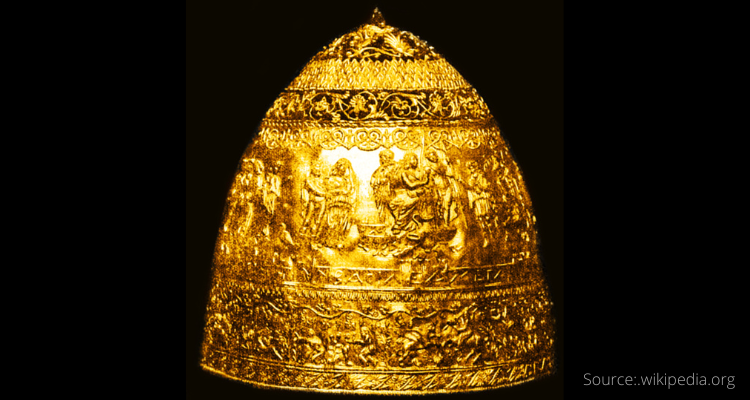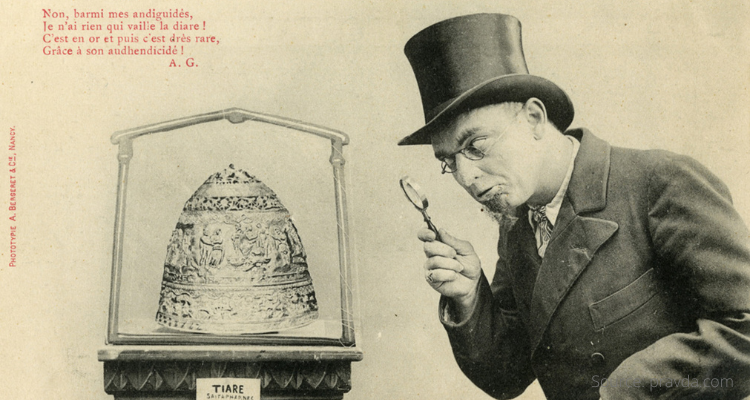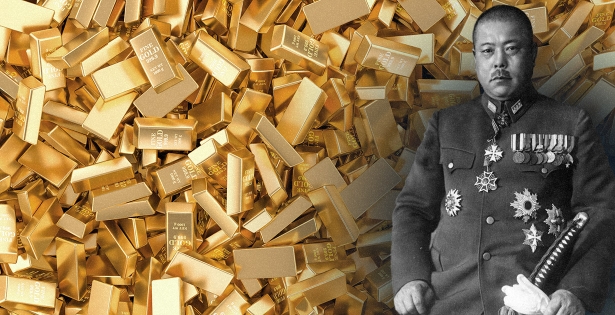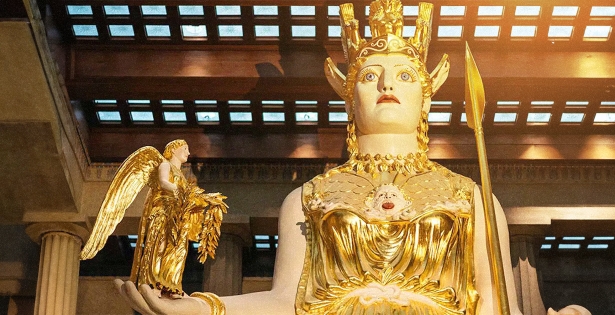
Stunning golden fake: Saitaphernes’ tiara
Average reading time — 4 minutes.
Bold plan
This incredible story began when two persons came up with a fantastic plan that turned the whole Europe upside down.
An enterprising antique dealer Schapschelle Hochmann lived in Ochakov. He had an amazing imagination and once came up with the idea that the ancient Olbian Protogen presented a gift to King Saitaphernes which consisted not only of 900 coins, but supposedly a precious crown as well. Thus, in 1895, the idea of creating the most famous fake was born.
A year later, in Odessa, the talented jeweler Israel Rouchomovsky realized this idea and created a unique golden tiara of the Scythian king Saitaphernes.
Brilliant masterpiece
Schapschelle made preparations to ensure that the item made of the precious metal did not raise any doubt. He found books and catalogs on the art of antiquity, atlases, pictures, engravings, and handed over all the materials to the jeweler.
Israel Rouchomovsky sweated over the tiara for eight long months and received 1,800 gold rubles for the completed work.
The ingenious self-taught master created his masterpiece from the thinnest strip of gold, which Schapschelle Hochmann gave him. According to the jeweler’s description, it ended up being an unusual headdress in the “shape of a tall pointed yarmulke”. Perhaps the tiara will remind someone of a precious helmet.

In the photo: the tiara is made of 486 grams of gold, the height of the item is 17.5 centimeters, and the diameter is 18 centimeters.
On his masterpiece the jeweler depicted scenes from the works of Homer, winged animals, exotic beasts and bizarre plants, as well as everyday scenes from the life of the Scythians.
The tiara is decorated with an inscription in ancient Greek:
"The council and citizens of Olbia [honor] the great and invincible King Saitaphernes"
Deception of the century
In 1896, the Hochmann brothers went to Europe. In Vienna, they turned to the Imperial Museum, where scientists, archaeologists and art historians confirmed the authenticity of the unique find. However, the museum could not buy it due to lack of funds.
The British Museum also regretfully acknowledged the impossibility of the desired purchase.
Then, on behalf of the Hochmanns, the then-famous antiquarian Anton Vogel, together with the broker Szymanski, made an attempt to sell the tiara to the Louvre employees. The highest quality of work, the uniqueness of the rarest exhibit was assured by scientists from various countries.
The Louvre agreed to purchase the most valuable tiara for 200,000 francs, an unprecedented sum for that time, which famous art patrons of Paris agreed to raise.
In the hall of ancient art of the largest museum in the world, a new exhibit appeared, which was proudly shown to visitors.
For exactly seven years, from 1896 to 1903, the amazing creation of the Odessa master struck the imagination of connoisseurs of ancient art.
The greatest surprise
All this incredible story outraged the creator of the tiara, Israel Rouchomovsky. Understandably, he was pleased with the fact that the golden creation was exhibited in the greatest museum in the world — the Louvre. However, the master was upset that many people were enriched at his expense, and he himself remained on the sidelines. Passions ran high, the voices of those who doubted the authenticity of the gold item grew louder.
According to one version, in order to put an end to this odd story shrouded in rumors, the French consul personally turned to Rouchomovsky. He wanted to get the answer: whether the tiara is genuine, or if it was made by the Odessa resident.
A commission with the participation of orientalists conducted an investigation for two months, the evidence provided — the real tools of the master — became the final proof. In addition, Israel Rouchomovsky managed to reproduce certain fragments of the tiara.

In the photo: cartoonists received many reasons to create their masterpieces featuring the fake tiara.
Epilogue
World fame fell upon an ordinary and unknown jeweler. Fortunately, Israel Rouchomovsky was not prosecuted, because the sale of the tiara was not his doing.
The amazing story of the talented master ended with award: at the Salon of Decorative Arts he was awarded a III degree medal for outstanding achievements in jewelry craftsmanship.
The famous tiara is still kept there, in the Louvre. You can see it in the hall of decorative arts.
Copies of the stunning work of the Odessa jeweler are in the British Museum, the museums of Tel Aviv and Baden-Baden.
Read also the article:
Legacy of the dynasties: precious tiaras




